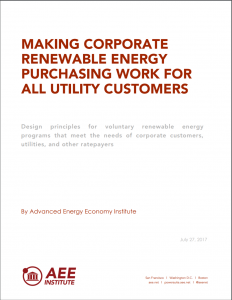Full Title: Making Corporate Renewable Energy Purchasing Work For All Utility Customers
Author(s): Advanced Energy Economy Institite
Publisher(s): AEE
Publication Date: July 1, 2017
Full Text: Download Resource
Description (excerpt):
Across the country, a growing number of companies have set renewable energy and energy-related sustainability targets, with 71 of the Fortune 100 companies now committed to reducing their energy-related impacts and over 100 companies globally pledging to source 100% of their electricity needs from renewable energy.1 More importantly, companies are not only making commitments on paper, but following through with them in reality; since 2012, corporations have purchased over 8 gigawatts (GW) of renewable energy from offsite projects.2
To date, most projects serving corporate demand for renewable energy are in states with competitive electricity markets in which customers are able to choose their electricity supplier, while states with vertically integrated utility markets have seen relatively few deals. Onsite renewable energy generation is an alternative available in most markets, but may not be sufficient to meet corporate needs, or may be less desirable than contracting for renewable energy offsite. In response to the growing corporate demand for renewable energy, vertically integrated utilities have started to introduce voluntary renewable energy offerings that allow customers to purchase renewable energy within the context of a traditionally regulated electricity market. In particular, some utilities have developed voluntary programs that allow customers to purchase bundled renewable energy and renewable energy certificates (RECs) at longterm, market-based prices. These programs are often referred to collectively as “renewable energy tariffs” or “green tariffs,” although details vary greatly.
There has been concern in some states that these programs may unintentionally result in higher electricity costs for utility customers who do not participate in these programs. This issue brief from Advanced Energy Economy Institute (AEE Institute) explores case studies and presents best practices for the design of voluntary renewable energy tariff offerings that meet the needs of participants without impacting other utility customers. AEE Institute finds that by appropriately allocating the costs and benefits of these programs to participating customers, utilities and regulators can design programs that meet companies’ needs while ensuring that nonparticipants do not bear any of the direct costs of these programs. Although optimal program design will depend on state-specific circumstances, there are eight general principles that policymakers, regulators, and utilities should apply to ensure that participants are able to benefit while protecting nonparticipants from an impact. Specifically, such programs should:
1. Charge participants according to the actual cost of serving them;
2. Pass RECs and REC costs to participants;
3. Charge transparent, cost-based administrative and program fees;
4. Set fair termination requirements;
5. Consider the impact of costs and benefits outside the scope of the program;
6. Enable participation by both new and existing customers;
7. Allow participants to negotiate special contracts to fit their unique needs; and
8. Set a regular schedule for program review.
Following these principles will ensure that corporate procurement delivers on its potential benefits to the grid, nonparticipating customers, and the local economy.
